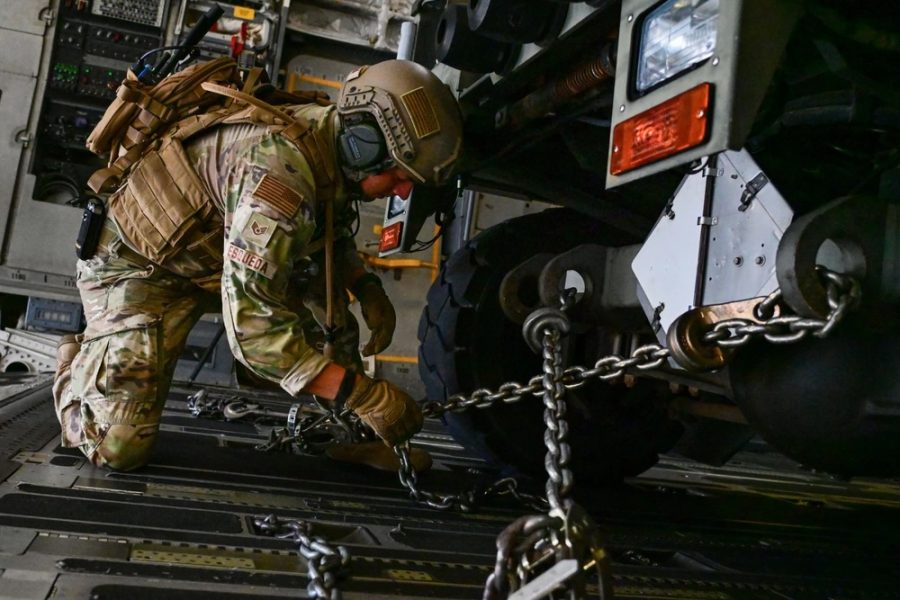MOJAVE, Calif.—It was a quiet Sunday morning before the C-17 arrived. Hundreds of wind turbines churned the 100-degree desert air over the nearby Tehachapi Mountains, and the only air traffic above the Mojave Air and Space Port was a football tossed back and forth by a few Airmen waiting on the sun-blasted flightline.
But when the whale-shaped transport jet with its four roaring engines finally appeared in the empty blue sky, the Airmen put down the football and donned ear protection as they prepared to download the gray beast’s precious cargo.
Time was of the essence: the C-17 had a long list of stops to make and material to move before the start of one of the Air Force’s largest exercises of the year, which would see thousands of troops and more than 150 aircraft practice air warfare over the deserts, valleys, and waters of the west coast. The aircrew would keep the engines running to avoid the long shutdown and restart process; but that also put pressure on the ground crew to move its 25 tons of unwieldy cargo as quickly as possible.
Luckily, Engine-Running Offloads/Onloads (EROs) were nothing new for the seven Airmen waiting on the flightline. An experienced crew from the 621st Contingency Response Squadron, the team included aircraft maintainers, airfield managers, and, perhaps most important for this exercise, aerial porters. Also known as “port dawgs,” aerial porters take cargo and people off and on military aircraft under difficult conditions and tight deadlines.
While it sounds simple, aerial porting is a delicate balance of math, physics, technique, and elbow grease which, if improperly mixed, can endanger aircrews and slow the movement of war-winning equipment or life-saving supplies by days when every minute counts.
“Planes are most vulnerable when they are on the ground,” said Lt. Col. Andrew Morris, director of operations for the 621st. “The faster we can get the stuff on and take it off, the better it is for them.”
The C-17 touched down at about 10:19 a.m. on Aug. 4. The clock began to tick.
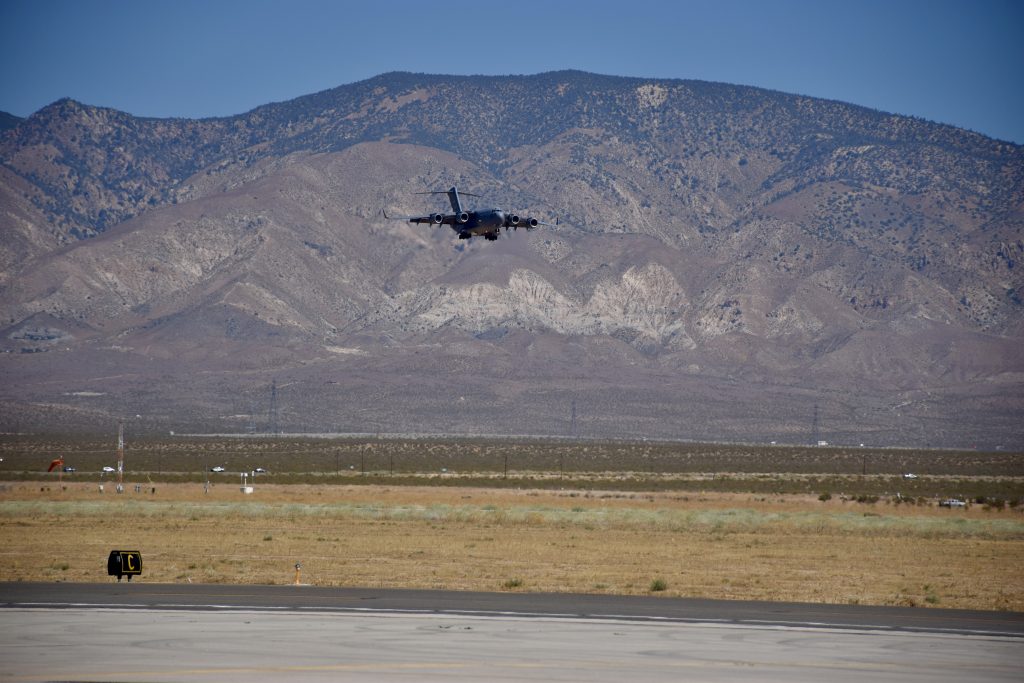
The Art of the Load Plan
The Mojave download was part of a new series of exercises called Bamboo Eagle, where combat aircraft operate out of small, scattered air bases instead of large ones that present juicy targets for long-range missiles. The concept is called Agile Combat Employment (ACE), and it requires working closely with mobility aircraft—the transports and tankers that move bomb carts, generators, and other equipment for re-arming and refueling combat aircraft.
“Air Combat Command does not have a heavy port footprint, so when they’re trying to establish their mission generation force elements [MGFEs], they need someone to catch that equipment that comes on cargo aircraft: all the things they need to bed down a base,” said Lt. Col. Andy Nation, commander of the 621st.
At Bamboo Eagle, the simulated war lasted from Aug. 5-10, but in the days leading up to it, mobility Airmen prepositioned combat equipment at unfamiliar airfields in a system of hubs and spokes across the West Coast. Port dawgs not only load and unload the aircraft, they also design the load plan, the blueprint for what cargo goes where on an aircraft.
A poor or unsafe load plan can have serious consequences; too much equipment on the plane’s tail end can prevent takeoff, while fuel leaks or loose parts can damage the aircraft or the crew if a steep bank or climb sends parts flying through the hold.
Calculating a solid load plan involves a long list of factors such as the weight and center of balance for each piece and how it effects the plane’s center of gravity. For example, the T-tail of a C-17 generates lift, which pushes the nose down and makes it fly less efficiently, a key factor in the Pacific where places to land may be few and far between, explained Tech Sgt. Russell Basile, one of the port dawgs at the Mojave airport.
“So if I put the cargo weight in the back to settle the tail down, the pilots have to use less trim to fly the aircraft straight and level,” Basile said, “and when it’s flying straight and level, it’s the most fuel efficient.”
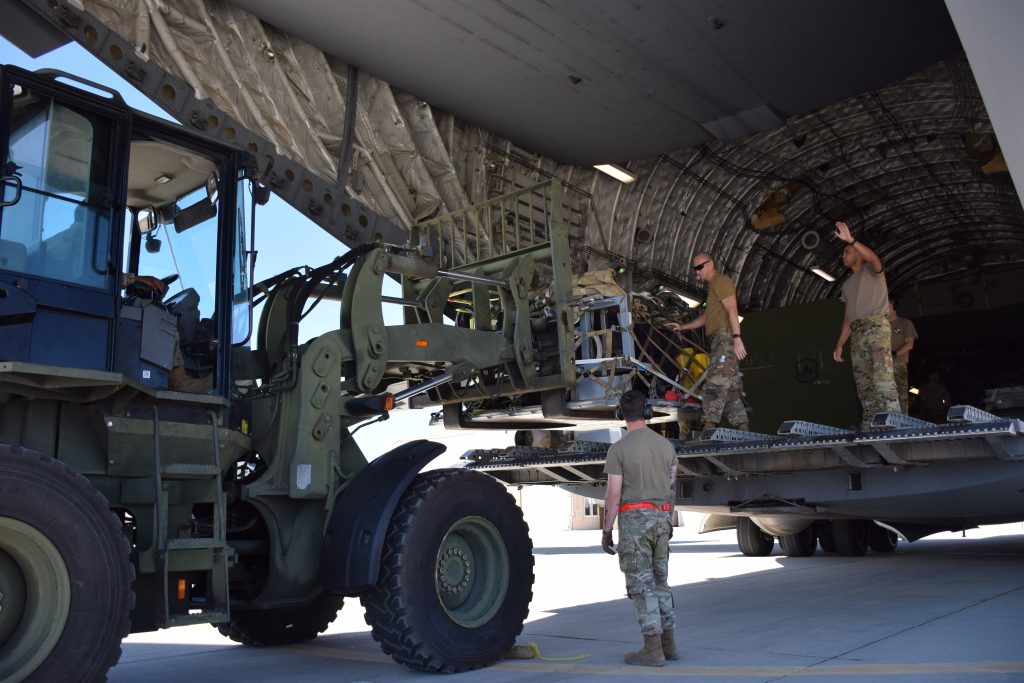
To make things easier, the length of the C-17 cargo hold is marked with numbers like a ruler, and the center of balance on cargo pieces are marked with duct tape and aligned with those numbers according to the load plan.
Port dawgs also have to consider the cargo’s weight under three Gs, which means an 11,000-pound piece has to be secured as if it weighs 33,000 pounds. The porters and loadmasters use chains to tie down the cargo, but different chains support different amounts of weight. Likewise, a C-17 has 295 rings on its cargo deck for tying down chains and straps, but the weight tolerance varies between rings.
To make things even more complicated, all the chains and straps have to be arranged symmetrically and in pairs, and they have to secure the movement of the piece in multiple directions, which means there is a specific way to tie down cargo.
“It’s playing Tetris and putting puzzle pieces together,” Basile said. “And as you’re putting the pieces together, you’re also thinking ‘How am I going to balance everything? And how is it going to be for tie-down?’”
Experience Counts
Regulations require the load plan be put together six hours before an aircraft’s scheduled departure. But once the load plan is complete, the cargo still needs to get onto or off the jet via a forklift, a conveyer belt, or just rolling it up or down the ramp, all of which takes math, since the forklifts can take only so much weight and the cargo ramp may be too steep or shallow for the piece rolling off.
There’s an entire agency, the Air Transportability Test Loading Agency at Wright-Patterson Air Force Base, Ohio, that certifies cargo for air transport and calculates things like the degree pitch for getting the cargo down a ramp, sometimes just based on photos and measurements sent by the port dawgs.
“They can generate a cert letter saying, ‘hey, based on the dimensions of that bomb loader and the degree pitch of the ramp, if we don’t decrease the angle, then it’s going to scrape the ramp as it goes down,’” Basile explained.
The port dawgs keep scraps of wood and other materials that serve as “shoring,” which lets expensive cargo safely on and off the aircraft. Juggling all these factors with jet engines running takes practice.
“Experience is looking at the piece and knowing immediately, ‘hey, I’ll need shoring for this, I just don’t remember the dimensions. Where’s the cert letter?’” Basile said.
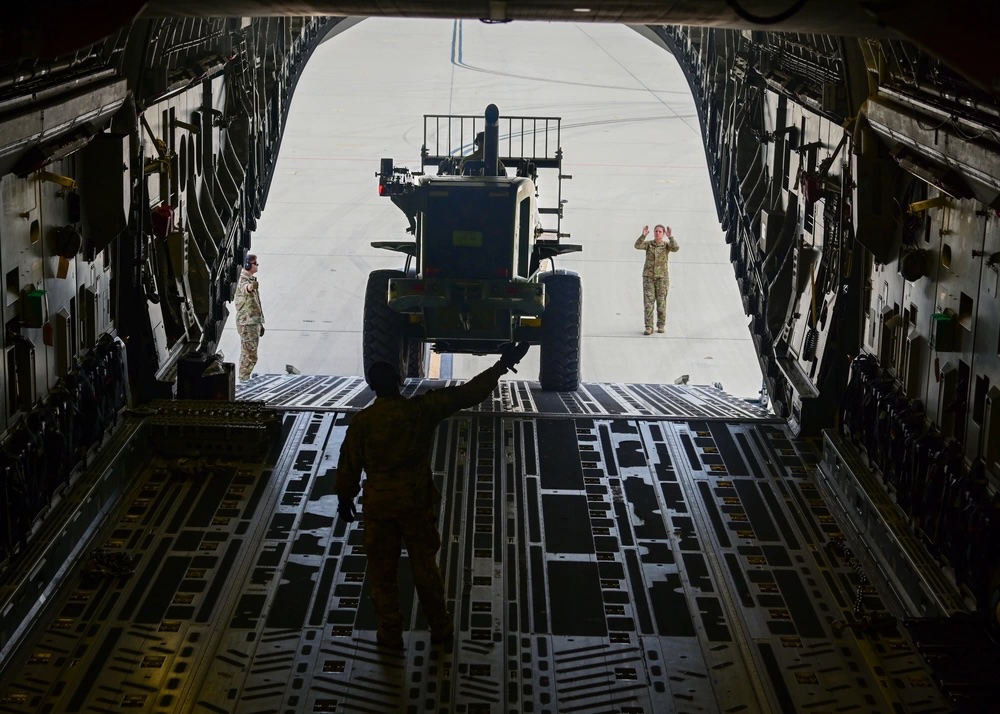
Loading cargo via forklift also takes experience: it can take as long as six months to master the All Terrain Materials Handling Forklift, a green behemoth that port dawgs rely on to move up to 10,000 pounds over non-paved surfaces.
“Like with everything, proficiency takes time,” said Senior Airman Victor Colas, another port dawg at the Mojave airport.
The ‘AT’ tends to be the most important piece of equipment port dawgs take downrange with them, Colas said. They can even take the cab off the top so it can fit aboard a C-130, though that requires removing a counterweight and lowering the AT’s lift strength to about 8,500 pounds. Forklift availability makes a big difference, said one of the pilots of the C-17 that flew into Mojave on Aug. 4.
“If you have only one forklift and a cargo load full of pallets, it’s going to take a while,” said Capt. Robert Talbot of the 15th Airlift Squadron. If there are not enough aerial porters around, sometimes the pilots pitch in to move the cargo. Those changing factors mean crews are constantly “recrunching, rethinking about the time you need on the ground,” Talbot said.
The port dawgs at Mojave went to work fast, falling into a choreography guided by hand signals and huddles with the loadmasters. For all the math and machines port dawgs rely on, sometimes it takes raw elbow grease to move cargo on and off aircraft, a tall order in the 100-degree Mojave morning.
There are worse conditions: Senior Master Sgt. Doug Karaffa remembered his boots sticking to a runway in Iraq under 142-degree heat. Still, port dawgs are “blessed,” he said, because at least they can take off their uniform blouses and often don’t have to wear body armor or weapons like Security Forces Airmen or the trigger-pullers in other services.
Acing ACE
Bamboo Eagle is meant to prepare the Air Force for ACE, which aims to project airpower with the smallest, most maneuverable logistical footprint possible. The port dawgs at Mojave belong to the 621st Contingency Response Wing, which specializes in standing up air bases at austere locations. But even the CR field wants to go smaller for ACE: a new feature at Bamboo Eagle was the Contingency Support Element (CSE): teams of just seven or eight Airmen who can fly out to a spoke, download all the cargo that combat aircraft and ground crews need to start turning fighters, then fly out to a new location.
“Our job is to be on alert for any mission that comes in,” said Staff Sgt. Jonathan Esqueda, who led one of the CSEs at Bamboo Eagle under the 521st Contingency Response Squadron, a component of the 621st Contingency Response Wing.
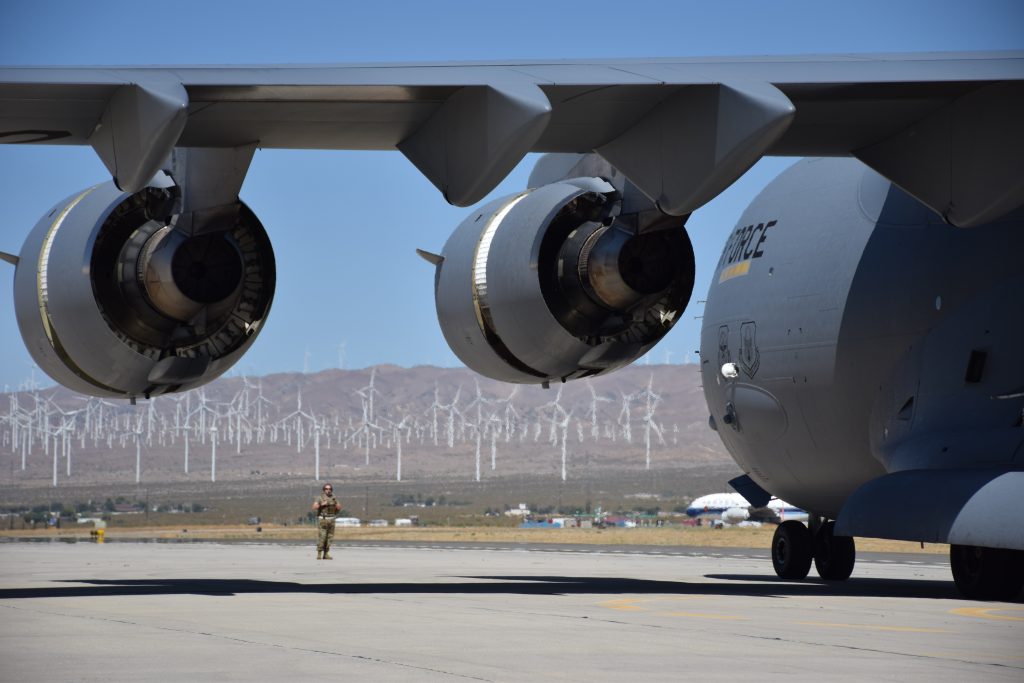
Esqueda and his six CSE teammates packed 72-hour bags so they were ready to fly out with an aircraft and download its cargo at a moment’s notice, a rare opportunity in the aerial port field, where most squadrons remain at a single base and work regular schedules.
“I’m usually just in one location, working 12-hour shifts, and that’s it, so this is awesome to me,” Esqueda said.
The card game Spades is a pastime among port dawgs, Esqueda said, and with good reason; several flights at Bamboo Eagle were delayed or canceled when jets broke down or cargo was improperly configured, which slowed the prepositioning process and led to CSE teams waiting for flights that never arrived.
To illustrate how complicated Air Force logistics can get: half the aircrew aboard the C-17 at Mojave was from Joint Base Charleston, S.C., while the other half and the jet they flew was from Joint Base McGuire-Dix-Lakehurst, N.J., and the cargo they carried was from the 388th Fighter Wing at Hill Air Force Base, Utah, but they picked it up at Travis Air Force Base, Calif.
To an extent, Bamboo Eagle was designed to practice dealing with those complications. But when the port dawgs finally had a chance to do their job, they didn’t disappoint. At Mojave, the team of porters and loadmasters finished downloading 50,340 pounds of bomb transport carts, nitrogen carts, air conditioning systems, and other gear with just one forklift in about 40 minutes.
That kind of speed “is on par with an experienced crew,” Basile said, as the unladen C-17 taxied back onto the runway. “When you have loadmasters and aerial porters on the same wavelength, it’s like ‘hey, we know what we’re doing, let’s just go.’”
